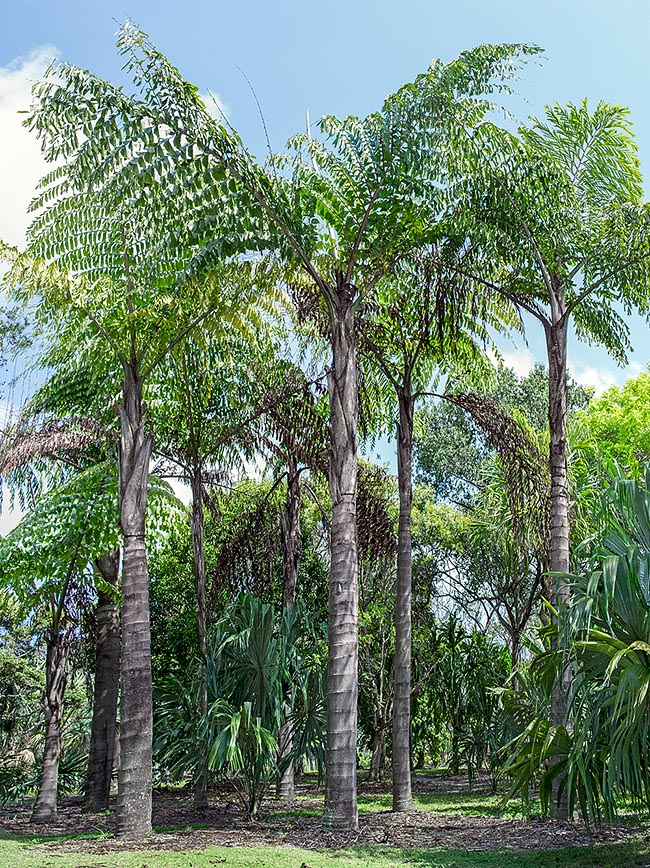Family : Arecaceae

Text © Pietro Puccio

English translation by Mario Beltramini

Native to mountains of China, India, Laos, Myanmar and Thailand, Caryota obtuse can be 15 m tall with enormous leaves of great effect. Unluckily, it blooms only once and then dies when only 15-20 years old © Giuseppe Mazza
The species is native to China (Yunnan), India (Arunachal Pradesh, Assam and Manipur), Laos, Myanmar and Thailand, where it grows at the borders to the humid mountain forests between 1200 and 1800 m of altitude.
The name of the genus is the Latin substantive of Greek derivation “caryota, ae” = date, fruit of the palm; the specific name is the Latin adjective “obtusus, a, um” = blunt, obtuse with reference to the bevelled toothing of the apex of the leaflets.
Common names: black trunk palm, fishtail palm, giant fishtail palm, mountain fishtail palm, Thai mountain giant palm (English); dong zong (China); bura suwar (India); tao rang yak, tao rang yak nan, tao rang yak phukha (Thailand).
The Caryota obtusa Griff. (1845) is a monoecious species, monocarpic (it fructifies only once and then dies), in cultivation 10-15 m tall, up to more than 30 m in nature, with cylindrical solitary stem, often swollen by the central part and provided at the base with a cone of aerial roots having a support function. The stem is pale grey marked by the foliar scars, spaced 20-30 cm, of the fallen leaves, and covered by a thin blackish tomentum in proximity to the top. The leaves, on a 1-2 m petiole provided at the margins with blackish fibres, are bipinnate (except in the juvenile phase) with triangular profile, 4-6 m long and more than 3 m broad, with 18-22 primary pinnae on both sides of the rachis, up to about 3 m long with the terminal part bent downwards, and coriaceous leaflets cuneiform obliquely, 20-30 cm long and 7-12 cm broad with dentate-crenate apex. Very ramified inflorescences, on a robust peduncle, drooping, 3-6 m long, with ramification of the first order, produced in sequence from the apex towards the base (basipetal), bearing yellowish unisexual flowers arranged in triads (one female flower between two male ones); the male flowers ripe before than the female ones (proterandry) thus favouring the crossed fecundation. The blooming lasts some years and by the ripening of the fruits of the lowest inflorescence the plant dies. Globose fruits of reddish colour when ripe, of 2,5-3,5 cm of diameter, with irritating pulp due to the presence of needle-like crystals of calcium oxalate, are therefore to be handled carefully, containing one or, more frequently, two seeds.
It reproduces by seed, previously kept in water for two days, in draining organic loam maintained constantly humid at the temperature of 26-28 °C, with germination times of 1-3 months.
One of the most spectacular palms in absolute due to the huge leaves, of great effect as isolated specimen, but with rather short-lasting life, about 15-20 years, not suitable for its size to small and medium gardens and with not a few problems when removing the dead leaves and plants. Cultivable in the humid tropical and subtropical regions and marginally in the temperate-warm ones, where it can resist to values of temperature around -3 °C for a sort time. It requires full sun, but a slight shading when young, and rich soils, draining, slightly acidic to slightly alkaline, maintained humid, even if it resists to short periods of drought, but with a slower growth. The central part of the stem, rich of starch, is utilized in some locations as food, cutting the stem before the blooming, this has caused a decrease of the number of specimens in nature.
Synonyms: Caryota obtusidentata Griff. (1850); Caryota rumphiana var. indica Becc. (1877); Caryota gigas Hahn ex Hodel (1998).
